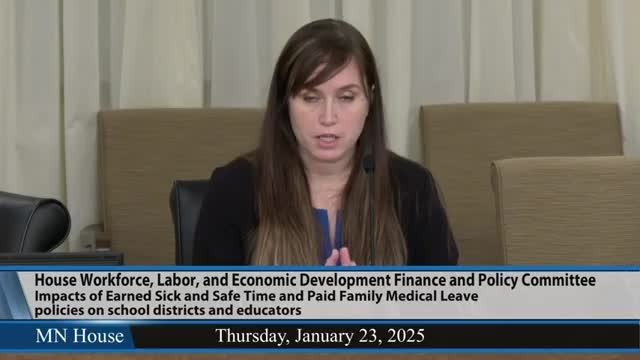School district faces $250K payroll tax increase amid rising substitute costs and teacher absences
January 23, 2025 | 2025 Legislature MN, Minnesota
This article was created by AI summarizing key points discussed. AI makes mistakes, so for full details and context, please refer to the video of the full meeting. Please report any errors so we can fix them. Report an error »

During a recent meeting of the House Workforce, Labor, and Economic Development Finance and Policy Committee, significant concerns were raised regarding the financial pressures facing Minnesota's school districts. With a projected budget of $4 million for the upcoming year, which constitutes about 3% of the overall budget, districts are bracing for potential reductions in teaching staff, with estimates suggesting a loss of 22.2 full-time equivalent positions.
The discussion highlighted the increasing challenges of managing teacher absences, which have surged to over 6,000 substitute requests in the past year. This trend, coupled with a 2% to 6% monthly increase in teacher leaves, is raising alarms about its impact on student achievement. Research indicates that absences exceeding 10 days can lead to a significant decline in math scores, underscoring the urgency of addressing this issue.
Financially, the costs associated with teacher absences are mounting. Each absence costs approximately $240 for substitutes, and with an anticipated increase of $13,000 in substitute expenses this year alone, the total substitute bill could reach $1.2 million. Additionally, transportation costs are also on the rise, with a 6% increase in busing contracts adding another $200,000 to district expenses.
The committee also discussed the implications of the new Paid Family Medical Leave Act, which is expected to impose an additional $250,000 in payroll taxes on districts. This cost is particularly burdensome as many districts already provide robust paid leave options for their employees. The rigid structure of the new legislation is seen as a barrier to honoring existing collective bargaining agreements, further complicating financial planning for schools.
In conclusion, while the intent behind new policies like the Emergency Sick and Safe Time (ESST) and Paid Family Medical Leave is acknowledged, the committee members expressed concern that their implementation is straining school budgets and hindering the ability to maintain quality education. As districts navigate these challenges, the need for flexibility in policy and funding is becoming increasingly critical to support both educators and students effectively.
The discussion highlighted the increasing challenges of managing teacher absences, which have surged to over 6,000 substitute requests in the past year. This trend, coupled with a 2% to 6% monthly increase in teacher leaves, is raising alarms about its impact on student achievement. Research indicates that absences exceeding 10 days can lead to a significant decline in math scores, underscoring the urgency of addressing this issue.
Financially, the costs associated with teacher absences are mounting. Each absence costs approximately $240 for substitutes, and with an anticipated increase of $13,000 in substitute expenses this year alone, the total substitute bill could reach $1.2 million. Additionally, transportation costs are also on the rise, with a 6% increase in busing contracts adding another $200,000 to district expenses.
The committee also discussed the implications of the new Paid Family Medical Leave Act, which is expected to impose an additional $250,000 in payroll taxes on districts. This cost is particularly burdensome as many districts already provide robust paid leave options for their employees. The rigid structure of the new legislation is seen as a barrier to honoring existing collective bargaining agreements, further complicating financial planning for schools.
In conclusion, while the intent behind new policies like the Emergency Sick and Safe Time (ESST) and Paid Family Medical Leave is acknowledged, the committee members expressed concern that their implementation is straining school budgets and hindering the ability to maintain quality education. As districts navigate these challenges, the need for flexibility in policy and funding is becoming increasingly critical to support both educators and students effectively.
View full meeting
This article is based on a recent meeting—watch the full video and explore the complete transcript for deeper insights into the discussion.
View full meeting
